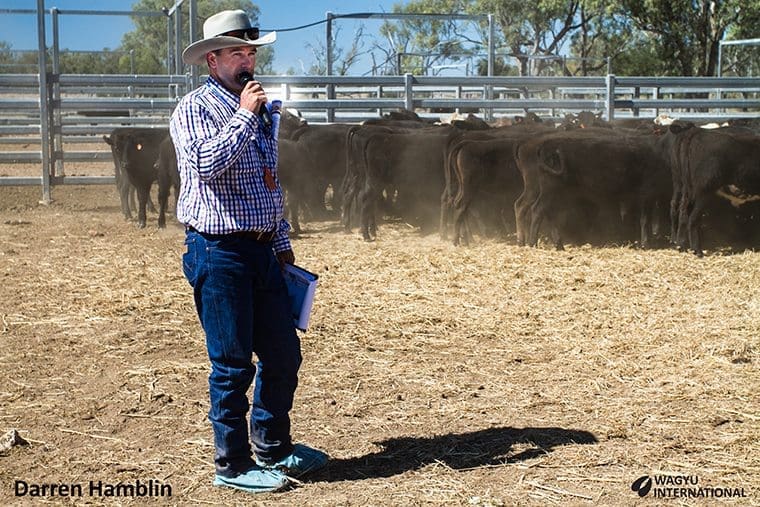
Darren Hamblin speaks to visits during a World Wagyu Congress visit to May Downs Station, Middlemount, in 2015. Photo: Steve Bennett, Wagyu International
CENTRAL Queensland commercial Wagyu producer Darren Hamblin collects and interprets data at a level that sets him apart from most commercial beef producers.
The former engineer and mining investor and his wife, Melanie, run five properties in the Mackay and Middlemount regions in Queensland. In the past 16 years they have built up an intensely recorded Wagyu Fullblood, F2-purebred and F1 herd using Shorthorn females as a base.
The aim is to turn off high-value Wagyu and Wagyu-cross feeder steers at 340kg liveweight at 14–18 months, to be finished on feed for 450 days.
For the Hambilns, data is king. The ultimate goal is to refine breeding to custom-produce carcases that satisfy market specifications every time, Mr Hamblin said.
“We would collect more data than most studs, but information – particularly pedigree and carcase data – is such a powerful tool,” he said.
“We’ve been recording stock data intensively since 1997 and I really appreciate now how much value it brings to our operation. I trust my decision making. It’s just a no brainer – I wouldn’t operate without it.”
Mr Hamblin admits data recording takes resources and time, however, over the years he has researched technology and increased each property’s recording capability so data is collected, stored and shared with relative ease.
“What information is collected should be determined by identifying a business’s profit drivers and what trait or other information influences them,” he said.
The information is primarily used to inform breeding and selection decisions as well as to identify which animals meet market specifications.
The Hamblins worked with Practical Systems to adapt their web-based stock recording program, Agrisphere, to their needs.
The system:
Equipment: Each of the five properties has the same set-up in the cattle yards, with live entry recording using built-in RFID tag readers.
Staff: One family is employed on each property, as well as an overall remote data manager.
Data: Every time an animal enters the yards, its weight and treatments are recorded (including chemicals and batch numbers). All joining details and pedigrees are recorded, including artificial insemination, embryo transfer and in vitro fertilisation, and all resulting pregnancy and calving details. Sale and carcase details, including the full AusMeat assessment and export requirement assessments, are also collected.
Back up: All data is shared between properties on a web-based tool, encouraging interaction between staff and reducing the risk of data loss due to hardware failure.
Mr Hamblin said while the staff numbers were high compared to other similar-sized enterprises, their intense breeding program – which includes blanket AI programs with insemination on natural heat and no back-up bulls – means it is often “all hands on deck”.
“We have a split calving with about 60 percent of the herd joined in December/January and the remainder in June/July,” he said.
Managers record new calves and their pedigrees daily and any that are in doubt are DNA-tested to confirm parentage.
Mr Hamblin said his top data recording priorities for his herd were parentage and carcase data, followed by growth rates.
“A combination of this information enables me to select which animals are best suited to which breeding program in order to maximise our genetic gain and profitability.”
“If we have cows with inferior carcase attributes but they’re still fertile and good mothers, it makes sense to use them as recipients in our embryo transfer program, where they can produce a calf of higher value,” he said.
“My recommendation to producers would be that if you can do nothing else, at least capture pedigree and carcase data.”
New Poll Wagyu focus
The next focus for the enterprise is using data to increase the number of polled Wagyu.
As part of a new venture with Tasmania’s Hammond family and Scott de Bruin from Mayura in South Australia, the Hamblins have implanted about 1000 poll Wagyu embryos and are rearing 190 poll Wagyu calves with good marbling and genetics that will be adapted to northern Australia.
Source: MLA
